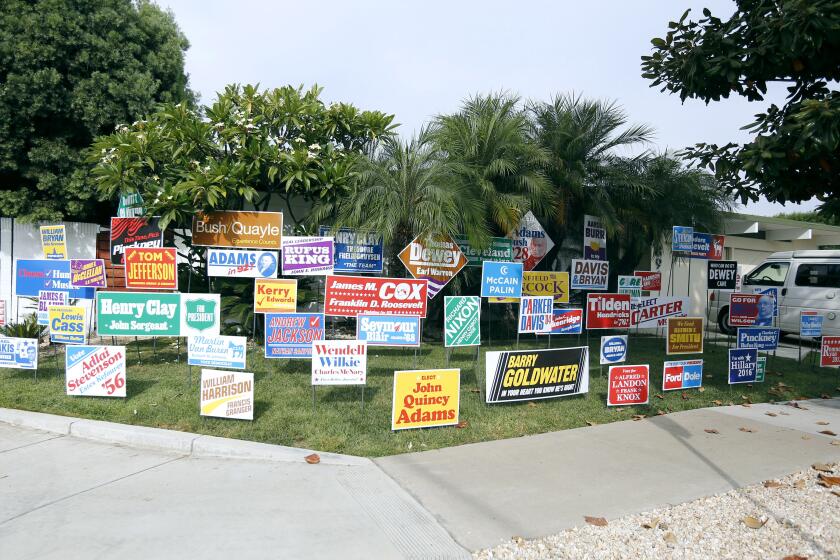6 artists display work online for Orange Coast College’s ‘Almost Presidential’ exhibit
Although arts director Tyler Stallings didn’t have gallery access to put together an in-person show, he didn’t want to let the “Almost Presidential” exhibit go. It’s an election year after all.
Instead he worked with curators and artists to reconfigure the exhibit as an online project through Orange Coast College’s Frank M. Doyle Arts Pavilion.
“Almost Presidential” features the work of six artists: Pio Abad, Deborah Aschheim, Matthew Brannon, Cintia Segovia and exhibition curators Marisa J. Futernick and Rebecca Sittler. Their new work focuses on presidents, failed presidential candidates or those who played supporting roles to presidencies. The scope of the online project isn’t limited to the U.S., but also extends to Mexico and the Philippines.
The artwork lives online on the Orange Coast College website as a photo slideshow. The artists will also be highlighted in an ongoing monthly newsletter, a film that will be released at the end of October and a recorded Zoom panel discussion that will be posted online for public viewing.
“It’s a way to extend the experience and part of it is to have a legacy beyond the exhibition,” Stallings said.
Nina Katchadourian’s “Monument to the Unelected” is a temporary installation consisting of 58 signs bearing the names of losing candidates from every U.S. presidential election. The installation is viewable on a residential lawn in Orange.
Coast Community College District announced schools, including OCC, will continue distance learning through the spring semester. Since the Doyle will remain closed in Costa Mesa, Stallings is planning on organizing online programming for the on-campus arts gallery throughout the year.
In the Oct. 1 Zoom panel, Futernick introduced the project and said the past elections may seem quaint in their sense of civility in comparison to the current election but “these histories both contained small seeds that have gone into this current moment that we’re living through as well as the possibility of imagining our way out of it.”
Futernick stages photos of herself wearing a paper facemask to assume the identities of multiple presidential candidates — from Barry Goldwater to Hillary Clinton — in the “Concession” installation. Nearly all of the candidates are male. Each photo has corresponding green text panels where she weaves together fictional lines and direct quotes from their concession speeches.
Aschheim and Segovia will be the first set of artists to be highlighted in the monthly newsletter.
For the show, Aschheim focused on John F. Kennedy and Richard Nixon. “November 14, 1960 (Key Biscayne)” are a series of ink drawings of the two presidents meeting for an hour for a peaceful transition of power after Kennedy won the election.
Aschheim said they aren’t necessarily failed presidential candidates since they both worked as presidents, but their terms were interrupted by either an assassination or resignation.
She used archival material, some of which she accessed through the Richard Nixon Presidential Library and Museum in Yorba Linda.
“It just seems impossible that I could have even lived in a time period where they’re people who are still alive that remember this afternoon and ... also are watching what’s playing out right now. It’s kind of mind-boggling to me,” Aschheim said on the Zoom panel.
Aschheim also discussed the “365 Days of Voters” project, an Instagram visual diary of voters documenting their stories and the communities they represent. Sponsored by the Los Angeles County Registrar-Recorder and arts commissions of L.A., Glendale and Pasadena, Aschheim takes headshot photo submissions and makes drawings to post on the account as well as to send a free physical copy to participants.
Segovia shared a video excerpt of “I Am Worth It, I Will Be Mexico’s President,” in which the artist explores the character of the latest female candidate who ran for presidency in Mexico — Margarita Zavala de Calderón, the wife of former President Felipe Calderón. The piece touches on the idea that machismo and the reputation of her husband played a role in her unsuccessful campaign.
“I wanted to show all the insecurities that she must have been feeling at the time and the idea that she was never going to be seen as an individual, but always be compared to her husband in the same way than other female candidates in the United States might have been looked at like Hillary Clinton,” Segovia said.
Stallings’ plan for the 2020-21 exhibition schedule was to focus on women in conjunction with this year’s 100th anniversary of the 19th Amendment passage. Most of the artists featured in “Almost Presidential” are women.
“What’s interesting is when artists deal with political and social issues because what art can do is help create a platform for discussion and can inject ambiguity back into a conversation where usually there’s a tendency to immediately categorize,” Stallings said.
All the latest on Orange County from Orange County.
Get our free TimesOC newsletter.
You may occasionally receive promotional content from the Daily Pilot.





